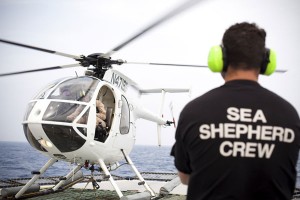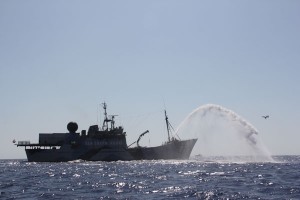Activists search for tuna boats with helicopter

Pilot Chris Aultman prepares to take off, from aboard The Steve Irwin—a Sea Shepherd Conservation Society boat, on a reconnaissance flight to check out fishing boats in the area, in the Mediterranean , Sunday, June 12, 2011. The helicopter lifted gingerly off the aft deck of the ship, banked sharply, then sped off a few hundred feet above the Mediterranean whitecaps in search of boats fishing illegally for bluefin tuna, potential targets for activists determined to do what they can to preserve the species. (AP Photo/Michelle McCarron, Sea Shepherd Conservation Society)
The helicopter returned nearly two hours later, however, with no new targets to report — having scouted, among other things, an EU fisheries inspection vessel, a pleasure craft with picnickers, and a vast empty sea near the border between Libya and Egypt.
But the chopper — an MD550E, a civilian version of a helicopter designed for scouting missions in Vietnam — is evidence of the increasing sophistication of the Sea Shepherd Conservation Society.
These are not wild-eyed radicals putting to sea in any old rustbucket. The group’s current campaign, which it calls Blue Rage 2011, uses two ships and a number of small launches, sophisticated radar and communications equipment — and the helicopter, flown by former commercial pilot Chris Aultman.
The aim is to try to prevent illegal fishing for bluefin tuna. The stock of the fish has dwindled to the point that experts fear its collapse. If the group finds boats it feels it can prove are fishing illegally, it wants to send divers in to cut the nets and free the tuna.
But the group’s methods are controversial. The conservation group Oceana shares Sea Shepherd’s assessment of the imminent danger to the bluefin tuna, but is more circumspect in its comments on Sea Shepherd’s tactics.
Article continues after this advertisement“Although Oceana doesn’t have the same practices, we don’t oppose those practices,” said Maria Jose Cornax, an official with Oceana. “They are contributing to the same goals we are.”
Article continues after this advertisement
In this photo provided by the Sea Shepherd Conservation Society, a French military jet encircles the Steve Irwin, a Sea Shepherd Conservation Society boat, as it attempts to disrupt illegal tuna fishing in the Mediterranean on Saturday, June 11, 2011. (AP Photo/Sea Shepherd Conservation Society, Michelle McCarron)
“They are not policemen,” Drewes said. “No third party has policing obligations or powers. Every 12-year-old kid knows that.”
Brigitte Scheffer, a spokeswoman for Sea Shepherd, said the organization has never claimed police powers.
“What we are enforcing, if we have any legal standing here, is the U.N. Charter, where we believe each individual has the right to defend nature and in our case marine wildlife,” Scheffer said.
But no one can question the group’s increasing sophistication. And part of that is due to the aviation program built up painstakingly over the past few years by Aultman. The helicopter he flies off the back of the Steve Irwin, Sea Shepherd’s mother ship in this campaign, is worth about $850,000 — probably $1.4 million if it were new.
Scheffer said all the organization’s money comes from donations, large and small. Sea Shepherd has tax-exempt status as a charity in the U.S.
Aultman, a 41-year-old Georgia native who lives in Santa Monica, became friends with a member of Sea Shepherd’s board six years ago. They began diving together. And late in 2005, Aultman said, Sea Shepherd founder Paul Watson “told me to find a helicopter and buy it.”
It’s fast and powerful — a pilot’s helicopter, he said — and it skips above the waves at 80 or 90 knots (90-105 miles per hour).
Sunday, the first target, which had been spotted on the Steve Irwin’s radar, was a vessel that was towing two rings that looked like tuna cages — but there were no nets dangling from the rings. It struck Aultman as peculiar, but if there were no nets, clearly there were no fish.
The second vessel was clearly marked “EU Fishery Inspection” — not illegal fishermen but the police. The third was a trawler, probably bottom-fishing, clearly for something other than tuna.
Feeling that the area was covered by inspectors, and it was more likely to find uninspected boats elsewhere, the chopper headed east toward the Libya-Egypt border, just north of the NATO-enforced no-fly zone. But other than a pleasure craft with picnickers munching happily on the top deck, there was little but empty sea stretching out to the horizons. The whitecaps looked for an instant like boats but then dissolved and disappeared.
To return to the mother ship without running out of fuel, Aultman turned the chopper around.
He had no luck today, but Aultman feels fortunate to have left commercial flying behind and gone full-time with Sea Shepherd.
“I love it,” he said. “It’s become my life.”